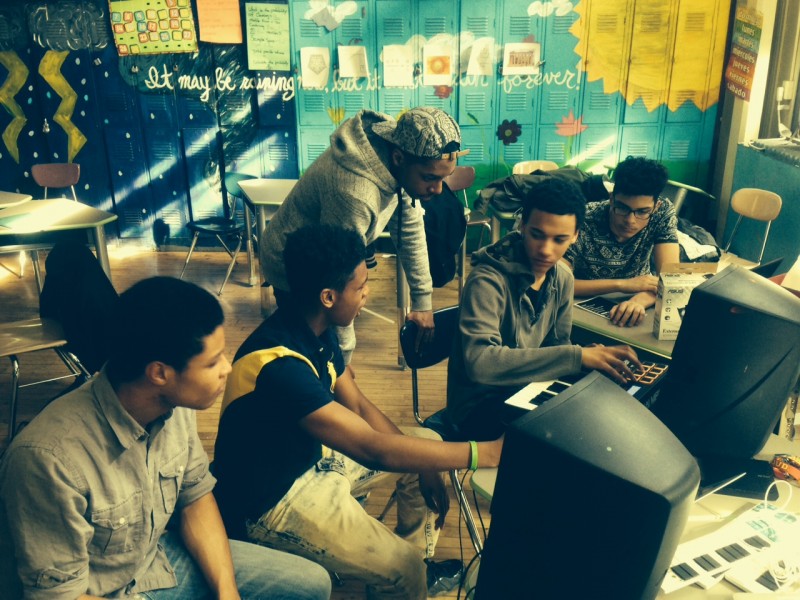Using Technology To Create The Music In Our Minds
Teaching beat making and digital music production is always as much of a learning experience for me as it is an opportunity to share my techniques and skills with my students. This semester at the James Baldwin School, I have been working with a great group of kids with a very eclectic set of sensibilities. Some already have experience using Fruity Loops, FL Studio, Ableton or other production software on their laptops and tablets at home to make beats or tracks. Some are completely new to the process music making. Still others have experience playing traditional analog instruments, and are interested in expanding their musical palettes. The key guiding principle for me as I work to guide each student toward their own personal music making goals is to instill in them an ethic of making music from intention. By this I don’t mean that that they need to decide in advance what their music means, or what experience the end listener will eventually have; although that is another, very interesting conversation. I simply mean that I encourage them to develop the skill of hearing the music in their heads, and having a vision of the ultimate result before setting ideas down. This is especially challenging at the present moment, because many production tools, and especially software based production methods enable us to bypass that step by using pre-existing loops and samples, and automatically time syncing them. Some even put them in tune with one another. While this allows for a neophyte to quickly garner immediate gratification, which can be confidence building; it allows also for a complete disconnect between what we set out to accomplish and where we arrive.
These days it is increasingly easier to arrive at a final result that sounds like “professional” work. Many of the pitfalls that music makers of past decades needed to learn to avoid through experience are automatically eliminated by more and more sophisticated software solutions. This might sound very helpful, and like it removes obstacles to create an easier path to creativity. While this is not entirely untrue, the trade off is that someone working in this way without basic musical knowledge is limited to using sounds and phrases that are created by others, and often don’t develop the skill of generating the sounds they conceive of themselves. They end up approximating, at best, what they originally intend, and are often sidetracked completely. They become dependent upon loop libraries and specific software in order to create music. The final product is often a compromise, and not what they might have created if they had the tools and skills to translate their own ideas directly into music. While even this methodology can be mastered and manipulated by the most diligent practitioners, most new users are wooed by the easy payoff and neglect to learn the most basic musical skills. An analogy would be learning to fly an airplane before learning to walk. While long distance flight is a useful skill, it would be difficult to get around once you landed anywhere.
In response to this dynamic, while I don’t discourage my students from applying any effective method to arrive at their ultimate goal, I do caution them about getting “lost in the box”, a phenomenon that happens when using technology without a clear goal. The danger is that there are so many choices of sounds and phrases, that it’s easy to lose sight of the original vision for a song or a track, and to get caught up, and ultimately overwhelmed and never arrive at a finished version of the work. If they do finish work, it often bears no resemblance to what music they were originally motivated to make. I instead work to instill in them a reverence for basic musicality, teaching them the mechanics of rhythm, harmony and melody both before we engage with the technology, and continually reiterating throughout the production process how the elements are present. It’s a modern application of the old adage “Give a man a fish, and he’ll eat for a day. Teach a man to fish, and he’ll eat for a lifetime.” Regardless of the instrument, technology, interface, or work style; fundamental musical skills provide the strongest foundation for creating music of any genre.
As a guitar player and teacher, I often suggest to students that they sing every note they are playing on the instrument in order to “keep themselves honest.” This approach requires a guitarist, or any melodic player to first know the note they mean to play, otherwise the note they sing and the note they play will not match. The level of focus and skill this technique demands of the user seems to be alien to many of my production students. The interface of digital instruments is often not applied as directly as that of an analog instrument, but it certainly can be.
Embracing this type of ethic cultivates a respect for, and helps develop a fundamental understanding of any topic. With that understanding, students begin on their own to desire to glean the basic skills of their craft. For my students, it also helps to peak their interest in music, and technologies that came before them, helping them see themselves as torch-bearers of a great legacy. I had the wonderful opportunity to meet the great musician and inventor Les Paul a few years back, and to hear him play. He was in his ’90’s at the time, and while many people are familiar with the guitars that bear his name, his lesser known accomplishments have shaped the way we all hear and create music today. As the inventor of the solid-body electric guitar, reverb, and multi-track recording, he created recordings that at the time sounded as though they were from another dimension. While on stage, he mentioned that, since he was the inventor of modern recording technology, many people ask him what advice he would pass on to emerging artists and young people getting into music making and production now. His response was priceless, and illustrates most clearly my modus operandi as I pass my own knowledge and experience to my students. He said, simply, “Figure out what you want to play before you turn the machine on.”
I took this to heart, and ask my students to first listen for music inside of themselves, and to see whatever tools they use as a means to get that music out of their minds and into the ears of the world.


